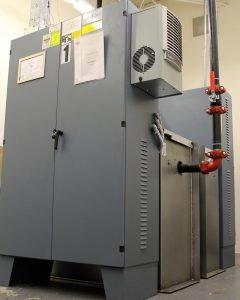Advantages of Hydraulic Elevators
 Hydraulic elevators can have many advantages when compared to traction elevators that have no machine room otherwise known as MRL’s. The main advantages can include reduced noise pollution, design flexibility, safety, easier maintenance and serviceability, economic installation, and reduced total lifetime costs.
Hydraulic elevators can have many advantages when compared to traction elevators that have no machine room otherwise known as MRL’s. The main advantages can include reduced noise pollution, design flexibility, safety, easier maintenance and serviceability, economic installation, and reduced total lifetime costs.
Noise Reduction with Hydraulic Elevators
One of the overlooked aspects to MRL’s is the amount of noise that can be heard from riders while they are riding within the elevator cab. MRL’s have their noise sources located within the elevator pit or overhead while traditional hydraulic elevators have their noise sources placed in elevator machine rooms located far away from the elevator hoistway.
Design and space can be advantageous to hydraulic elevators as well as they have a smaller space requirement for the elevator hoistway. In addition, they have the flexibility to allow for a great deal of design freedom for architects. MRL’s typically have smaller elevator cars due to the considerable space needed within the hoistway for sheave assemblies, counterweights, and machines while limiting an architect’s design options.
Hydraulic elevators are safe when considering the need to perform an emergency evacuation from an elevator. Emergency evacuation procedures are very simple and safe to perform on a hydraulic elevator when compared to the more complicated, and in some respects hazardous, emergency evacuation procedures of a traction MRL.
Minimum Service Needs and Greater Choice of Service Providers
With manufacturer-dependent systems from original equipment manufacturers (OEM’s) the operator is “locked in” to their maintenance and repair company as most of these designs are proprietary in nature and independent service providers are shut out. Additionally, they can have complicated work procedures with hazardous working conditions. On a typical hydraulic elevator, the operator has free choice of elevator maintenance companies with minimum service requirements ensuring a cost-effective solution.
A recent study on power consumption related to vertical transportation equipment found that hydraulic elevators can save as much as $800 annually for a hydraulic passenger elevator located in an apartment building. In addition, for buildings that are 5 stories or less the cost effectiveness of hydraulic elevators is unparalleled as traction MRL’s have very high costs for preventative maintenance, repair, and replacement parts.
